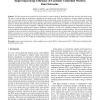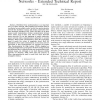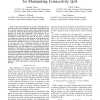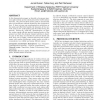442 search results - page 3 / 89 » An Energy-Conserving Access Protocol for Wireless Communicat... |
WINET
2002
13 years 7 months ago
2002
Wireless network access protocols can assist nodes to conserve energy by identifying when they can enter low energy states. The goal is to put all nodes not involved in a transmiss...
INFOCOM
2006
IEEE
14 years 1 months ago
2006
IEEE
— Distributed time synchronization is an important part of a sensor network where sensing and actuation must be coordinated across multiple nodes. Several time synchronization pr...
INFOCOM
2011
IEEE
12 years 11 months ago
2011
IEEE
—For energy conservation, a wireless sensor network is usually designed to work in a low-duty-cycle mode, in which a sensor node keeps active for a small percentage of time durin...
MDM
2010
Springer
13 years 10 months ago
2010
Springer
—Given the potential scale on which a Wireless Sensor Network (WSN) can be deployed, multi-hop communication will be a pivotal component of the system. When redundant nodes are d...
SECON
2010
IEEE
13 years 5 months ago
2010
IEEE




